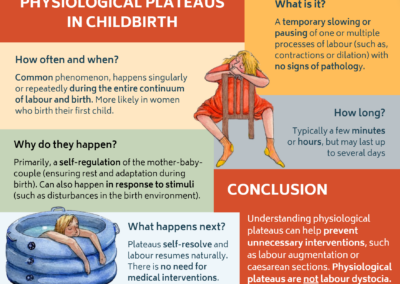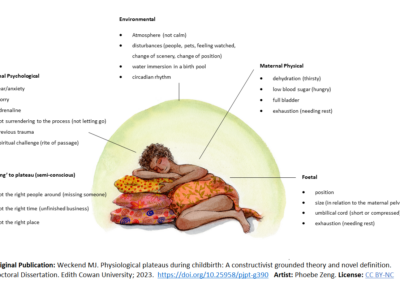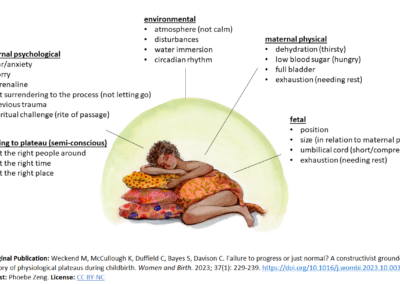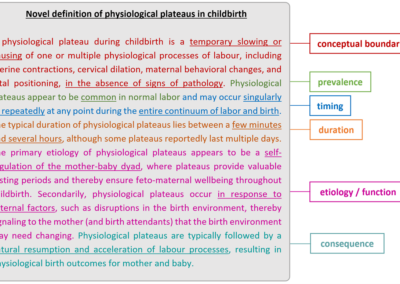Learning and Teaching
Keen to learn more about physiological plateaus in childbirth? This place offers answers to frequent questions, explainer videos and more for women and families, health professionals and birth enthusiasts.
Are you an educator? Scroll down for resources to use in your next teaching session and help us spread the knowledge about natural pauses during labour with your clients, students and colleagues!
Are pauses in labour normal?
Yes, pauses during labour and birth are perfectly normal. They can happen for many different reasons, at any time during labour, or even several times. Pauses during labour can be short, lasting only a few minutes, or long, lasting several hours. When the body decides to make a pause, there is likely a good reason for this. For example, labour may slow down or pause when the baby needs to wriggle into a better position for birth. Healthy pauses during labour mean that both mother and baby are well, and that there are no signs for concern. This is why such pauses are also called physiological plateaus (meaning healthy pause). Such natural pauses typically self-resolve, meaning that the body will intensify labour again on its own.


How to recognise pauses during labour?
Pauses during labour come in many different shapes and forms. Whenever labour slows down after it was previously intense, and mother and baby are well, this can be considered a healthy pause (physiological plateau). For example, imagine that the labour surges are already clockwork regular and strong, and then they gradually become less frequent, less regular, or much weaker – or disappear entirely for a while… then, after an hour or two, the surges slowly reappear and become regular and intense again. This is a typical example of a plateau during labour. Other times, the neck of the womb (called cervix) may have been opening up (dilating) continuously, but then stays the same for a while, or even becomes a bit smaller again. This is also considered a plateau, sometimes called cervical reversal. Plateaus during labour can also look like everything is very intense and overwhelming and then, things feel calm and easy again. The body has many different ways to take a pause during labour, and it is a good idea to listen to what the body needs.
Why can pauses during labour happen?
Labour can slow down and pause for many different reasons! The body and mind work closely together, so when labour slows down, this may have to do with what’s going on in the body or in the mind, or even in the environment.
Common mind-related reasons for pauses in labour are:
- Feeling worried or anxious
- Being reminded of a past trauma
- Not feeling ready to give birth
- Missing someone
Common body-related reasons for pauses in labour are:
- Being thirsty or hungry
- Needing sleep or rest
- Having to go to the toilet
- Baby needing to wriggle into a better position for birth

The birth environment also has a big impact on the labour pattern, and common environment-related reasons for pauses in labour are:
- Being distracted by someone or something
- Feeling threatened or not safe
- The birth space being too bright, noisy or busy
- Influences of the natural day-night-rhythm (circadian rhythm) and related hormones
Overall, natural pauses during labour mean that the body adapts to what is going on in the body, in the mind, and in the birth environment. Sometimes, these reasons can be addressed to help labour resumes naturally – such as helping women to feel safe. Other times, a pause is exactly what the body needs to sort things out by itself – for example, when the body needs rest or when the baby is adjusting its position in the womb. None of the reasons listed above are abnormal (pathological), which is why such natural pauses during labour are considered healthy and normal.

Which terms are used for pauses during labour?
Pauses that occur naturally during labour are called physiological plateaus – simply meaning that things slow down (plateau) and that this is healthy (physiological). We use the term physiological plateaus as an umbrella term for all kinds of natural pauses that can happen during labour. Some pauses also have their own names… for example, when things slow down late in labour, midwives may call this rest and be thankful phase or lull during transition. Other times, when the neck of the womb gets smaller instead of dilating, this might be called cervical reversal or cervical recoil.
Overall, there are lots of different terms for natural pauses during labour, but not much shared language. This is a big problem, because when we lack shared language for a phenomenon, we cannot effectively talk and learn about it. This is why we are advocating to use the term physiological plateau as a catch-all term until we have sufficient research on this topic, or until women tell us that they prefer another term (we are currently asking women for their favourite terms for pauses during labour). Of course, every language uses different terms. The image below gives examples of English terms alone, so you can imagine the multitude of different terms globally…
In Australia, the formal term physiological plateau and the casual terms labour lull and natural pause seem to fly well, but we will keep you updated! This website uses mainly labour pauses and plateaus (interchangably).
If there is no term for physiological plateaus in your language, please invent one and advertise it! This way, we can start talking about this fascinating phenomenon in all languages. We will open up a discussion forum soon, where you can share your favourite terms (and other thoughts) with our community.
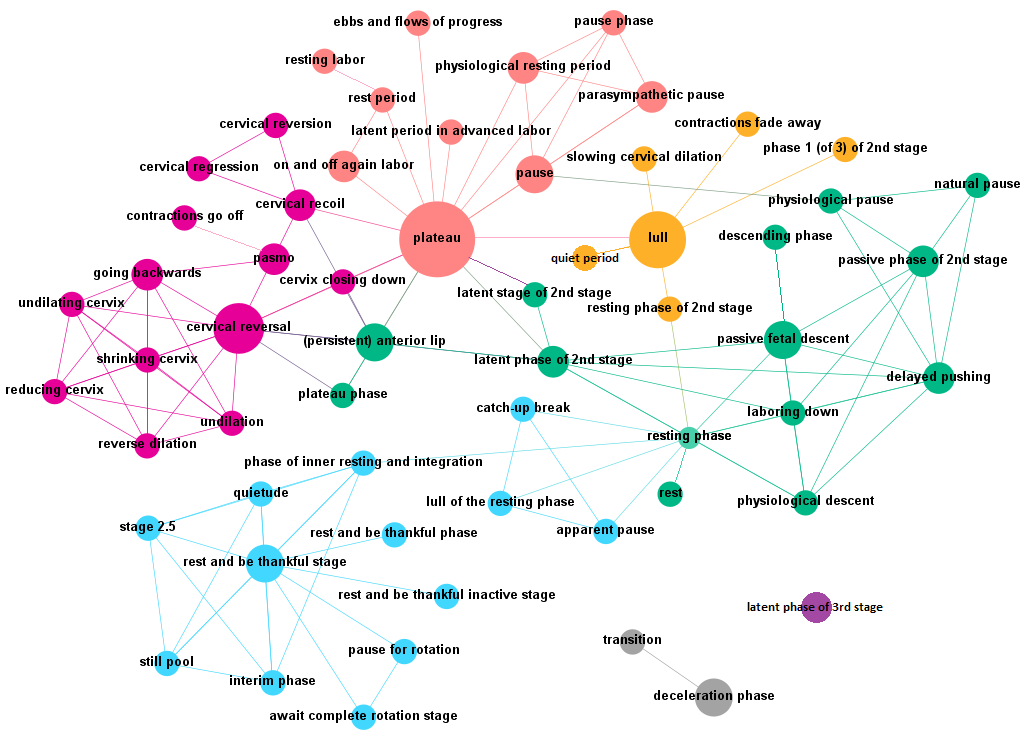
Can pauses in labour be a sign that something is wrong?
Yes, and no. Natural pauses during labour are not a sign that something is wrong. They are a way how the mother’s and baby’s body adapt to the effort of labour. Sometimes though, pauses can indicate that the birth environment is not quite right. For example, it might be noisy and busy, preventing the body to go into the natural flow of hormones that is required to start and sustain labour. For labour to work well, most women need a quiet and safe space, with as few interruptions as possible. Pauses during labour which happen for reasons that are not a birth complication but have to do with the birth environment are normal and common.

Rarely, birth complications can occur that might initially look like a natural pause although they aren’t. One such possible labour complication is labour arrest (also called labour dystocia, cephalopelvic disproportion or many other terms). Labour may arrest entirely if the baby is not in a suitable position to be born (such as having its arms above its head and trying to be born headfirst) – this type of complication usually requires the baby to be born by a caesarean section.
Midwives and obstetricians can safely distinguish physiological plateaus from birth complications. When you have a midwife or an obstetrician supporting you during labour, and things slow down, you do not need to worry – simply trust that your body knows exactly what it does. And trust that your health professional will recognise if there is a complication that needs stepping in, and will advise you if this happens.
What should I do if my labour slows down?
Quite frankly, nothing. Pauses in labour are a way how the body self-regulates. Trusting that the body knows what it does and letting the pause happen is often the best line of action.
It depends, however, a lot on the situation. If natural pauses happen because the birth environment is not ideal (noisy and busy), then changing the birth environment to a calm and safe space will help the birth hormones work their magic. Of course, if hunger or thirst are the causes of pauses, snacking and drinking makes total sense. If anxiety is the cause, then having a good cry and someone to listen can help wonders. But it’s important to remember that pauses during labour are not an abnormal thing that needs fixing. Pauses happen. And often, the exact reasons remain unknown. As long as mother and baby are well, there is no need for action when labour slows down for a while. When natural pauses happen, midwives often give the mother some space, facilitate a calm and intimate environment, and reassure the woman that everything is okay. Other times, if the woman prefers to reinvigorate labour, midwives might recommend a change of scenery, to walk stairs, or to have a sweet drink or snack.
Each woman is different. Each birth is different. Each pause is different.
And so, each response to a pause in labour is different. Some women enjoy the pause and go with the flow. Other women prefer to take action that steps things up again. Your midwife is there for you to help decide what you want to do (if anything) and to reassure you that pauses are perfectly normal.

Why dedicate a whole website to pauses in labour?
Glad you asked! Pauses during labour are mind-numbingly normal and at the same time breathtakingly new… Pauses have always happened during labour and midwives and obstetricians are familiar with this phenomenon since ancient times. But in the past 70 years or so, we have seen a development in maternity care that tends to “actively manage” women’s births. Today, when things slow down in a woman’s labour, this is often seen as an unnecessary delay. And it became common to recommend medical interventions to speed labour up again – so-called labour augmentation. Labour augmentation can include an artificial rupture of membranes (opening the water bag around the baby) or an oxytocin drip (medication to intensify the surges), but also other medical treatments. Such labour augmentation is common, affecting between 30% to 80% of women who birth in high-resource countries, globally.
However, research suggests that when labour slows down, something important is happening – such as the baby changing positions – and that artificially speeding things up can cause more harm than good. We also know from decades of high-quality research that too many unnecessary medical treatments are given to women who birth. Unjustified medical treatments carry risks and can cause complications, which often makes even more medical treatments necessary – a vicious circle, called intervention cascade. The global trend of over-treatment is also called childbirth medicalisation and the World Health Organization and other organisations have already flagged this as a huge problem in maternity care. Childbirth medicalisation is visible, for example, in rising numbers of women having a caesarean section, and fewer and fewer women experiencing a healthy vaginal birth (see graphs below).
This is exactly, where this knowledge hub about physiological plateaus comes in. If we accept that the body can make pauses during labour, and that these pauses are valuable, then we do not need to step in when it happens! Not stepping in means less labour augmentation, a reduction of preventable harm, and fewer preventable caesarean sections. This website is part of our larger effort to shift attention to the phenomenon of physiological plateaus, because we are convinced that this will help more women and families achieve a healthy and positive birth experience.
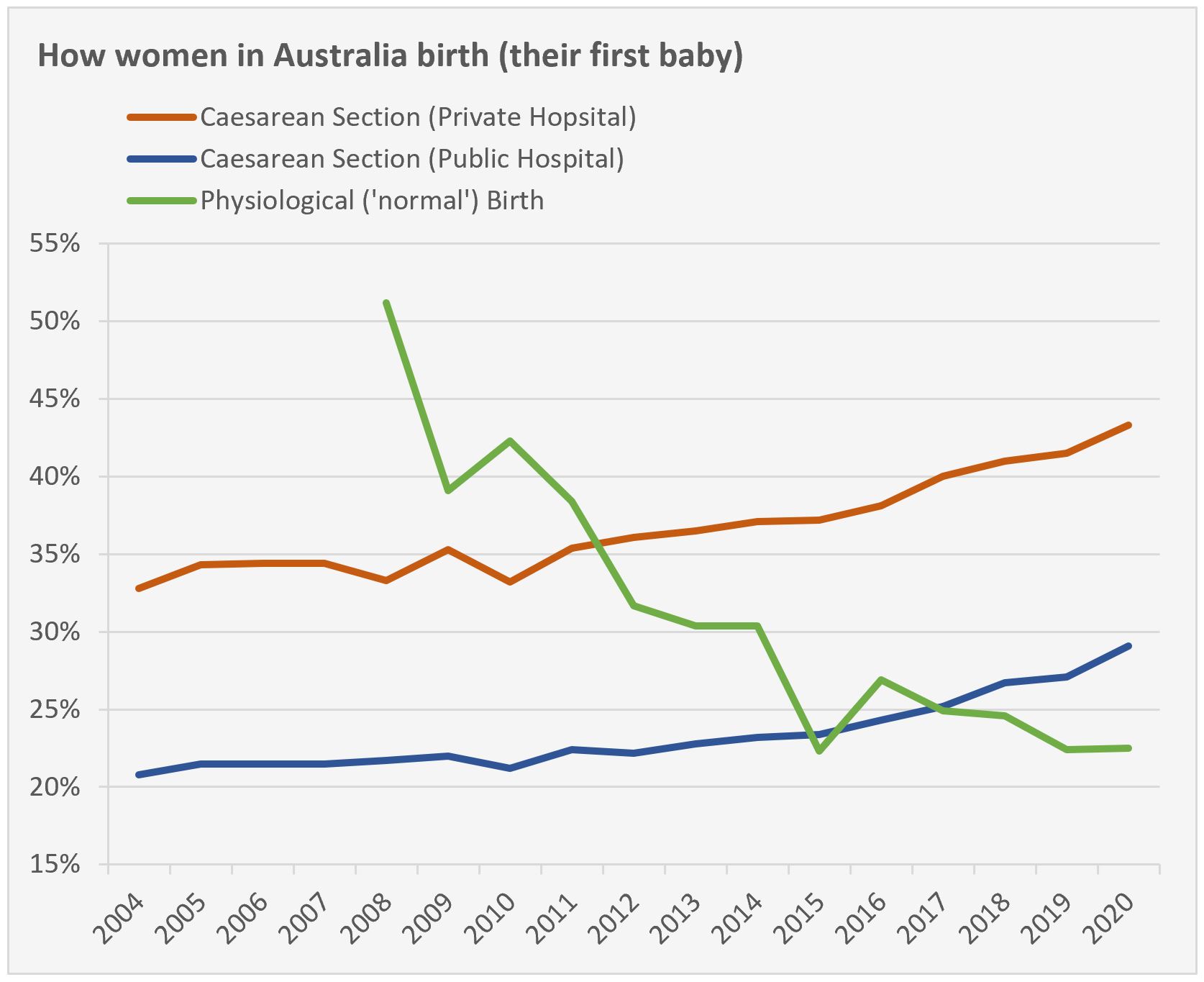
Figure: Based on data from the Australian Institute of Health and Welface (AIHW, 2022, Australia’s mothers and babies) and Women’s Healthcare Australia (WHA, 2023, Trends in maternity care & outcomes: Care during labour and birth). License: CC-0

Figure: Extract from Trends and projections of caesarean section rates: Global and regional estimates by A.P. Betran et al., 2021, BMJ Glob Health, 6(6), p.6. License: CC-BY-4.0
Currently, research on physiological plateaus is very limited. And not all health professionals are taught that physiological plateaus are normal. In fact, many medical textbooks about birth do not mention physiological plateaus at all (this is another thing we are working on). To shift birth culture away from medicalisation and towards individualised care – where pauses in labour are accepted – takes a huge effort that includes research, effective knowledge dissemination, and practice innovations. This is exactly what we are working on, and we cannot do this without you. Please share your knowledge and research with the world – for example by featuring it on this website! Share your publications, your experiences, your thoughts. Let’s have a vibrant conversation and shift birth culture for good!
Let’s be loud and rebellious, and bring the positive change that birth culture desperately needs!
Want to learn more about birth culture and labour plateaus?
The conference presentation below provides a glimpse into different birth philosophies and cultures, and how they can have a huge effect on the understanding of physiological plateaus during labour and birth. This is the corresponding publication:
Weckend M, McCullough K, Duffield C, Bayes S, Davison C. Failure to progress or just normal? A constructivist grounded theory of physiological plateaus during childbirth. Women and Birth. 2023; 37(1): 229-239. https://doi.org/10.1016/j.wombi.2023.10.003
Resources for Educators
Images
Images below are free to use in an educational context, licensed under creative commons licenses. You are welcome to use these images (or extracts thereof) in various formats, such as presentations, print materials, or online. Context for these images is provided in the following publications:
Weckend M, McCullough K, Duffield C, Bayes S, Davison C. Physiological plateaus during normal labor and birth: A novel definition. Birth. 2024; 00:0 https://doi.org/10.1111/birt.12843
Weckend M, McCullough K, Duffield C, Bayes S, Davison C. Failure to progress or just normal? A constructivist grounded theory of physiological plateaus during childbirth. Women and Birth. 2023; 37(1): 229-239. https://doi.org/10.1016/j.wombi.2023.10.003
Videos
The videos below, and elsewhere on this webpage, might be suitable to give a short introduction and overview of physiological plateaus – for example, in antenatal classes, or as an addition to lecturing materials. Feel welcome to embed, share, link, and disseminate freely.
Want to share your own materials?
Awesome! Have you designed a worksheet, PowerPoint slides, or other learning and teaching materials that might be useful for others? Please contact us if you are happy to share them, and we will embed them on this website together with a license that suits you. You can explore creative commons licenses here, or simply contact us and we will help you find the most suitable one.
Sharing is caring… thank you for spreading knowledge and teaching materials of physiological plateaus with our global community!

